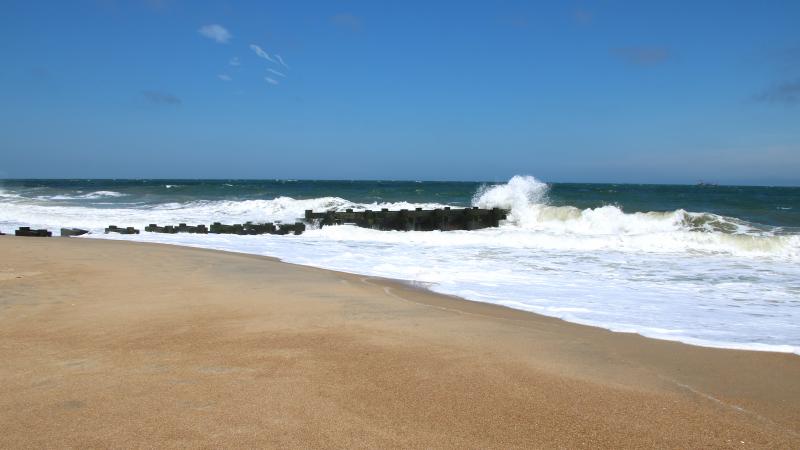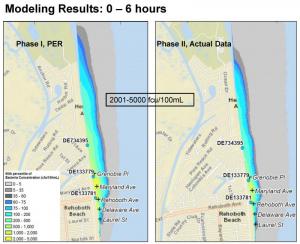The results of Rehoboth’s state-mandated stormwater study are in, and while they’re not as bad as models predicted, there’s no denying that for at least six hours after a heavy rainstorm, Rehoboth’s ocean has a higher-than-recommended concentration of bio contaminants.
During a commissioner workshop May 7, Leita Bennett, senior project manager for international-engineering firm GHD, said data collected following six major storms showed in the six hours immediately following those storms the ocean water near they city’s five stormwater outfalls from Grenoble Place south to Delaware Avenue averaged near 2,000 colony-forming units of enterococcus per 100 milliliters. She said the recommended level of colony-forming units is zero to 60.
Bennett said simulated modeling before testing showed a concentration of up to 5,000 units of enterococcus per 100 milliliters.
Stormwater testing was required by Delaware Department of Natural Resources and Environmental Control when it approved Rehoboth’s ocean outfall permits. Testing began in fall 2017, when water-quality samplers were installed to examine water from stormwater outfalls on Maryland, Rehoboth and Delaware avenues, Grenoble Place and Laurel Street.
The $250,000 study was the second step in determining how the city can reduce stormwater pollution. The first step was a report by GHD that identified enterococcus as the main bacteria found in the waters around Rehoboth’s stormwater outfalls.
Bennett said testing showed three outfalls – Maryland, Rehoboth and Delaware avenues – had a considerably higher concentration of enterococcus, which is found in the guts of all warm-blooded animals. Enterococcus levels are what DNREC uses to determine recreational swimming advisories in Delaware, with the threshold beginning greater than 104 colony-forming units per 100 milliliters. It is up to the town to order a beach closure.
Bennett said testing also shows that ocean flow does a slightly better job than predicted at flushing out contaminated water. Within 24 hours the level of enterococcus fell to zero during testing, although earlier modeling predicted it would be slightly above the 60 units.
Bennett also provided a list of recommendations; topping the list was finding the source of bacteria on Rehoboth and Maryland avenues and then reducing it. Other recommendations include cleaning filters more often and distinguishing human from nonhuman enterococcus.
Bennett said a water-flow model shows the only real way to keep the ocean waters near the shoreline below 60 units all the time is to extend four of the five stormwater outfalls 1,200 feet, at an estimated cost of $15 million. She said there was no need for an extension at Grenoble Place because that outfall’s output goes first to Lake Gerar, and much of the bacteria is killed there before entering the ocean.
Bennett said less-effective remedies include 175,000 square feet of permeable pavement on Rehoboth Avenue at $2 million, engineered sand filters at $740,000, and flushing 36,000 linear feet of pipe at $144,000.
Following the presentation, Mayor Paul Kuhns said it might be time to begin forcing the issue of cleaning practices with businesses and examining old infrastructure because “$15 million is way out of our bracket.”
Commissioner Stan Mills suggested increasing the scope of the study, because this round of testing included less than half of the nearly 650 catch basins in the city.
Commissioner Lisa Schlosser said she was in favor of implementing a citywide public education plan and then having City Manager Sharon Lynn come up with short- and long-term action plans to decrease the level enterococcus that gets into the ocean.
Editor’s note: This story has been updated to say DNREC issues recreational swimming advisories, not orders beach closures, when enterococcus levels are too high.
Chris Flood has been working for the Cape Gazette since early 2014. He currently covers Rehoboth Beach and Henlopen Acres, but has also covered Dewey Beach and the state government. He covers environmental stories, business stories and random stories on subjects he finds interesting, and he also writes a column called Choppin’ Wood that runs every other week. He’s a graduate of the University of Maine and the Landing School of Boat Building & Design.





















































